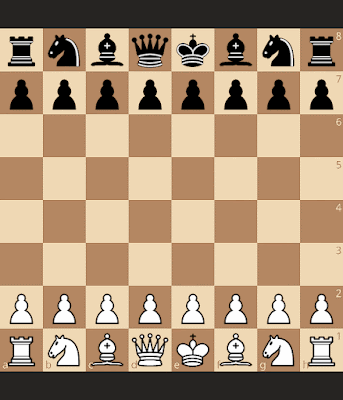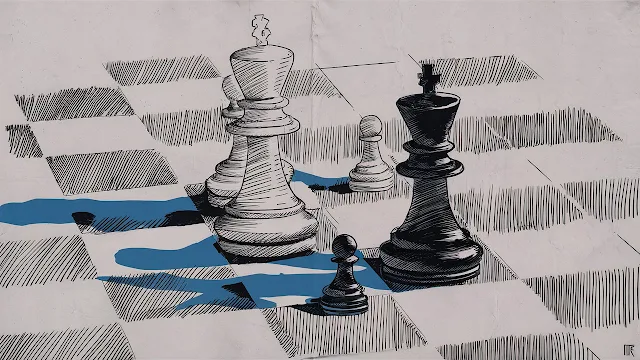
"Balance is key."

A Guide to the English Reversed Sicilian:
Beyond the Basics
Take your game to the next level with this advanced resource archive!
- Deep Dive into Critical Lines: Uncover hidden nuances, master strategic concepts, and refine your opening repertoire.
- Expert Analysis & Insights: Gain valuable knowledge from chess professionals and elevate your positional understanding.
- Sharpen Your Chess Skills: Challenge yourself with complex positions and decision-making scenarios.
- Deep Dive into Critical Lines: Uncover hidden nuances, master strategic concepts, and refine your opening repertoire.
- Expert Analysis & Insights: Gain valuable knowledge from chess professionals and elevate your positional understanding.
- Sharpen Your Chess Skills: Challenge yourself with complex positions and decision-making scenarios.
Focusing on (King's English) variations A20-A29, this collection offers in-depth analysis and strategic insights to elevate your chess.
 |
| English Opening - King's English |
Books & Courses
This section delves into resources designed to equip you with a strong foundation in the Reversed Sicilian (1. c4 e5).
Courses:
- Chessable: Short & Sweet: Reversed Sicilian (Free)
- Author: GM Arturs Neiksans
- Length: 27 Variations with 66 Minutes of Video
- Description: Don't be fooled by the "Short & Sweet" title. This course by GM Neiksans explores 27 critical variations, giving you a deep understanding of the opening's strategic themes and the dynamic possibilities that arise in the middlegame.
Books:
- Starting Out The English (PDF available on Internet Archive) by Neil McDonald
- Pages: 61 (Reversed Sicilian coverage on pages 115-126)
- Description: While this book primarily focuses on the English Opening (1. c4), it dedicates a section (pages 115-126) to the Reversed Sicilian (1. c4 e5). This can be a valuable resource, especially for beginners, providing a foundational understanding of how the English ideas translate when Black meets them with 1...e5.
Chess Articles
Reversed Sicilian: How Bojkov Created Beating the English - Chessable Blog - The article discusses GM Dejan Bojkov’s chess opening repertoire, “Beating the English,” which is based on the reversed Sicilian.
Reverse Sicilian LiChess Studies
Sharpen your skills in the Reversed Sicilian with these interactive Lichess studies!
- The English - Reverse Siciclian - 14 Chapter Study (White plays w/out g3) - This comprehensive study delves into White's repertoire when they choose not to play the typical g3 move. Explore various positional and tactical ideas that arise in these lines.
- English Sicilians: Reverse Sicilian Open - 4 Chapter Study - This study focuses on the different variations that can branch out from the Reversed Sicilian Open (lines without an early Nc3 for White).
- Reversed Sicilian (1.c4 e5) (for Black) - 6 Chapter Study - Equip yourself with a strong understanding of the Reversed Sicilian from Black's perspective. This study explores key ideas and potential plans for Black to take advantage of the initiative.
New to Lichess studies?
Lichess studies are a fantastic way to learn and practice chess concepts in an interactive format. You can explore different variations move-by-move, test your understanding by solving puzzles, and review key points with explanations provided.
Game Databases: Exploring the Reversed Sicilian in Action
Delve into real-game scenarios with these valuable resources from 365Chess.com! This database allows you to analyze and learn from thousands of games played by top players and amateurs alike.
365Chess.com
A20: English opening 1. c4 e5 - 58,783 Games (+ 2 sub-variations)A21: English opening 1. c4 e5 2. Nc3 - 41,552 Games (+5 Sub-variations)
A22: English opening 1. c4 e5 2. Nc3 Nf6 - 26,828 Games (+4 Sub-Variations)
A23: English, Bremen system, Keres variation 1. c4 e5 2. Nc3 Nf6 3. g3 c6 - 1767 Games
A24: English, Bremen system with ...g6 1. c4 e5 2. Nc3 Nf6 3. g3 g6 - 501 games
A25: English, Sicilian reversed 1. c4 e5 2. Nc3 Nc6 - 12,431 Games (+5 Sub-Variations)
A26: English, closed system 1. c4 e5 2. Nc3 Nc6 3. g3 g6 4. Bg2 Bg7 5. d3 d6 -
2106 Games (+1 Sub-Variation)
A27: English, three knights system 1. c4 e5 2. Nc3 Nc6 3. Nf3 - 4807 Games
A28: English, four knights system 1. c4 e5 2. Nc3 Nc6 3. Nf3 Nf6 - 14,080 (+8 Sub-Variations)
A29: English, four knights, kingside fianchetto 1. c4 e5 2. Nc3 Nc6 3. Nf3 Nf6 4. g3 - 6040 games
Puzzles: Sharpen Your Reversed Sicilian Tactics
WTHarvey.com Puzzle Collections:
English (ECO A20) 1.c4 e5 w/o 2.Nc3 - 17 puzzlesEnglish (ECO A21) 1.c4 e5 2.Nc3 - 11 Puzzles
English (ECO A22) 1.c4 e5 2.Nc3 Nf6 - 9 Puzzles
English, Bremen System, Keres Variation (ECO A23) - 26 Puzzles
English, Bremen System with ...g6 (ECO A24) - 14 Puzzles
English (ECO A25) 1.c4 e5 2.Nc3 Nc6 - 16 Puzzles
English (ECO A26) 1.c4 e5 2.Nc3 Nc6 3.g3 g6 4.Bg2 Bg7 5.d3 d6 - 17 Puzzles
English, Three Knights System (ECO A27) - 14 Puzzles
English (ECO A28) 1.c4 e5 2.Nc3 Nc6 3.Nf3 Nf6 - 18 Puzzles
English, Four Knights, Kingside Fianchetto (ECO A29) - 19 Puzzles
LiChess Opening Puzzles
ENGLISH OPENING: CARLS-BREMEN SYSTEM - 488 Puzzles - While not exclusive to the Reversed Sicilian, this collection includes puzzles relevant to the Bremen System lines (A23 & A24).
ENGLISH OPENING: KING'S ENGLISH VARIATION - 10,386 Puzzles - This broader category might contain some Reversed Sicilian puzzles, but be prepared for a wider range of English Opening variations.
Reversed Sicilian Video Lessons
Dive deeper into the Reversed Sicilian with these insightful video lessons from various chess instructors!
Reversed Sicilian - Discussion with GM Pavel Eljanov - 77 Min - Modern Chess - He will present a selection of his most instructive games in this opening. During the analysis, GM Eljanov will talk about basic positional ideas, pawn structures, and theoretical trends.
The Reversed Sicilian: 1.c4 e5 · English Opening Theory - 1.5 Hr - Hanging Pawns - A comprehensive guide on the Reversed Sicilian, specifically the English Opening with 1.c4 e5. It discusses various strategies, pawn structures, and responses to different black moves highlighting the benefits of playing with an extra tempo as white.
English Opening Reversed Rossolimo Variation (Chess Openings) - 13 Min - Chess Mode - Today, we have looked at the reversed rossolimo with 4.Bb4. This is a pretty interesting way for black to play
Chessbase India
- Sagar's English Love Part II | Reversed Dragon with 8...a5 - 32 Min - Sagar begins with 1.c4 e5 and shows you some reversed Dragon positions. There are three games covered in this video.
- Sagar's English Love Part III | Reversed Dragon Main Line in English Opening - 36 Min - Part III deals with the main line of the reversed Dragon system.
English Opening Reversed Dragon Variation (Chess Openings) - 18 Min - Chess Mode - Show you basic ideas and plans for for white and black in this variation of the English.
English Opening - Reversed Dragon - 17 Min - MKS Chess - Dragon reversed is an excellent way to meet blacks most popular move against the English opening of 2...Nf6.
Playing Against the Reversed Sicilian
- GM Neiksans Boot Camp #37: Neutralize English Opening - 1.5 hr - Gm Neiksans - how to neutralize English Opening. Why fight for equality when you can treat it as Sicilian but colors reversed?
- A SIMPLE System To Beat The English Opening - 10 Min - NM Nelson lopez - It provides a clear plan for the middle game by trading a bishop for a knight and placing pawns on dark squares to limit the opponent’s dark-squared bishop’s effectiveness. The system is demonstrated through a game.
- How to play the Reverse Sicilian against the English - 21 Min - Rober Plunketts Chess Lab
Game Videos (w/Analysis)
Observe top chess players navigate the complexities of the Reversed Sicilian with these annotated game videos!
English Opening - King's English Variation - 4 Video playlist
English Opening (Reversed Sicilian) | The Sensei Speedrun | GM Naroditsky - 10 Min
Master Class | English: Reversed Sicilian | Chess Speedrun | Grandmaster Naroditsky - 34 Min
Reverse Acc. Dragon | English Opening | GM Naroditsky’s Top Theory Speedrun - 63 Min - presents a comprehensive guide to the English Opening in chess, focusing on principled play and the importance of controlling the center. He discusses various strategies, including the accelerated dragon setup
Reversed Sicilian problems - Ding Liren vs Hikaru Nakamura - 14 Min
NEW IDEAS in the Reversed Sicilian! - FF2 (in SF ) vs Stockfish 15 - Kramnik-Shirov Counterattack - 19 Min - Jozarov's Chess Channel - engine game.
Standard Chess #138: Seibt vs. IM Bartholomew (English Opening) - 31 Min
Blitz chess postmortem #481: English opening - Reverse Sicilian - 7 Min - Jim's Chess Channel
Blitz chess postmortem #985: English opening - Reverse Sicilian - 19 Min - Jim's Chess Channel
Blitz chess with live commentary #985: English opening - Reverse Sicilian - 21 Min - Jim's Chess Channel


